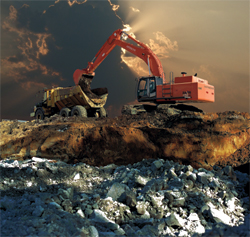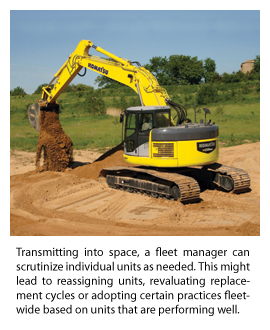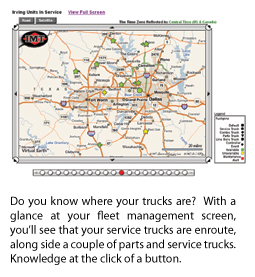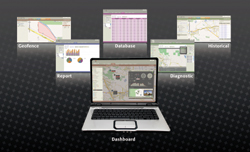Equipment Equinox!

According to ancient contractor lore, construction equipment mysteriously assembles at a secret meeting ground twice a year, allowing fleet managers to assess their inventory of iron. This Equipment Equinox was the rare occasion when fleet managers could take stock of their equipment, plan out new orders, rework maintenance schedules and retire old and obsolete tools.
Between these two annual events, the fleet manager would use everything from a pad and paper to a white board and Excel spreadsheet to keep track of the equipment.
“A manager tracked his vehicles by contacting drivers over the phone or reviewing their previously planned schedules on paper to guess where they were,” says Jeffrey Cohen, CEO of Intergis LLC — a company offering GPS vehicle tracking and navigation technology based in Cranford, N.J. “The process was reactive and supervisors never had accurate, real-time information when they needed it. Challenges included major delays in receiving vehicle information, if it was received at all, and longer decision making processes as a result. The fleet manager couldn’t concentrate on other issues at hand since he constantly had to pinpoint trucks [and equipment] manually.”

The hardware gathers information from the machine and relays it to the fleet manager’s computer, e-mail or even cell phone. Reports provide daily, weekly and monthly summaries, but can be as accurate as down-to-the-minute updates, depending on the parameters provided by the user. You’ll know the exact hours a piece of machinery worked, its digging and load and carry cycle times, engine idle and machine shutdown. At times, machine operators work long, laborious hours and toward the end of the week, so it can be difficult to break those hours down. If there is ever a discrepancy of hours worked, the fleet management system has tracked and logged it.
“Those areas that represent the biggest impact to the bottom line should always take priority and fleet management software can help managers focus on those activities,” says Lance Massey, Director of Channel Management for Borg Solutions. “In general, maintenance and repair and fuel consumption will always be the two biggest fleet operating expenses. Fleet managers need to understand the activities that drive these expenses for their own business and, in turn, utilize technologies that help manage and prioritize those activities.”
In addition to the machine operation, the GPS tracking can be employed to keep an eye on where your machine is, in addition to what it’s doing. Using geofencing, or geozones, allows the fleet manager to set up invisible fences that confine the equipment. The fleet management system’s software sets (either hard disk-installed or Web-based) a square or circle perimeter, depending on the system, and alerts will be sent when the equipment leaves that defined area. It allows a fleet manager to monitor when equipment is on or off the job. This in turn, allows for analysis of material deliveries, routes and utilization of equipment on the job accurately, not to mention the ability to set up alerts if the machine leaves a designated area in the case of a theft.
Equipment-centric Theology
The sheer amount of data and features can spin a contractor’s head. After all, fleet managers of old used simplistic methods of indirect communication, scribbled notes and the relation of the sun to the Earth’s horizon. Today’s fleet management software is as easy to use as checking your e-mail. While the method of managing a fleet might be changing in our technology-driven lives, the role of the fleet manager is not.
“It’s not fleet management software that requires a dedicated fleet manager; it’s the nature of the fleet and the information that needs to be processed that requires a dedicated fleet manager,” says Steve McGough, COO for HCSS. “Software is a tool that should be used to solve your business problems. If you cannot process all the information currently, you need software to help.”
While some are quick to embrace new technology, it can be intimidating for some. The biggest hurdle in implementing fleet management is the resistance to change and technology.
“Some companies don’t want to learn something new because their current system is one that they have had in place for many years and are accustomed to it,” McGough explains. “‘Why try to fix something that isn’t broken?’ is the approach that some people have. The other part of resistance is when technology plays a big role in the change.”
The benefits of fleet management software greatly outweigh the technology reservations. The plethora of new fleet management software — offered by aftermarket gurus like Borg Solutions, Topcon, HCSS, Intergis, Earthwave Technologies and DPL America, as well as OEMs like Komatsu, Caterpillar and John Deere — doesn’t replace the staff fleet manager. For a fleet manager looking to improve efficiency and increase productivity (and who isn’t in today’s economic market), fleet management provides the tools to do so.
“I think the best question that can be asked of a fleet manager is how they measure and control operating expenses,” says Massey. “This will quickly demonstrate to a contractor those managers who truly understand the impact fleet operating costs have on the bottom line and those who simply are ‘minding the store.’ A manager who is focused on continuous improvement of the fleet management process will be naturally predisposed to embracing applications that can drive down costs. Additionally, those same managers will only accept applications that can clearly improve inefficiencies with current processes.”

“It takes time to set up the program and begin administering it, but once this is in place, the system runs smoothly,” says Tim Worman, Product Manager of Commercial Vehicles at Iowa Mold Tooling Co. Inc. (IMT), maker of ValuePlus Fleet Management software. “Some of this initial legwork includes identifying equipment components and their [preventative maintenance] schedules, as well as sorting out expenses by unit.”
The first step is to thoroughly assess the current fleet management operations and identify those areas in need of improvement. From this assessment, a list of requirements pertinent to selecting a solution that will solve the contractor’s challenges and reduce operating costs will come to light.
Second, it must be understood that fleet managers and their staff will likely have to change their current processes somewhat. Too often contractors look for fleet management software that exactly mirrors their current processes. If their current processes are that good, then there is no need for a new system, explains Massey.
Third, a staff member needs to be made the owner of the fleet management system with that person becoming an expert on its uses. This individual will be responsible for training others and developing new uses.
Finally, the contractor needs to establish the key measurable operational aspects and continually monitor how effective the staff is in controlling those measures.
“Viewing access should be open to a wide audience, including the staff associated with budgeting, maintaining, repairing and operating the machines,” says Ken Calvert, Director of IT Support for Komatsu. “The ability to administer the software, grant viewing rights and input data should be controlled by a system [owner].”
All systems come with different security protocols and data storage parameters. It is important that the contractor establish a minimum level of acceptable security (it may be necessary to engage an IT expert or consultant for this) and have the software provider clearly demonstrate compliance with those levels.
Fleet management technology helps managers prioritize,” says Worman. “Understanding simple utilization standards and providing exception reports on usage and expense can reveal a lot of crucial information. After analyzing these reports, a fleet manager should scrutinize individual units as needed. This might lead to reassigning units, re-evaluating replacement cycles or adopting certain practices fleet-wide based on units that are performing well.”
Assembling the Fleet
While the Equipment Equinox is an archaic form of fleet management, it does have one advantage — uniformity. All the equipment — new and old — assembled at the same location. Unifying your fleet under the same fleet management system isn’t as simple. Many new machines from manufacturers such as John Deere, Hitachi, Caterpillar and Komatsu come with optional fleet management hardware and software. The dilemma comes into play when trying to unite those systems with an already-implemented OEM or aftermarket system.
There are a couple of ways for a contractor to unify the fleet: 1) Install common technology on each unit in the fleet. So if you have an aftermarket system, it’s easiest to install that hardware on the new or new-to-you machines. 2) Extract common data points from the different systems and unify the data within an enterprise business system. This would be additional software that works in tandem with the existing fleet management software.

If that is not possible, having the ability to export information from the hardware manufacturer and importing it into the fleet management software is the next best choice. If either of those are not possible, the fleet manager is stuck with managing the fleet across the various systems.”
Before choosing a costly and time consuming solution, it’s best to talk with your existing fleet management service provider beforehand. They can offer advice and guidance on how to go about uniting your fleet.
When all is said and done, you’ll have made a significant fleet management investment. Some service providers offer monthly subscriptions — ranging from $10/month to annual subscriptions of $360/year, depending on features, account preferences, etc. Then there’s the hardware cost for the physical GPS units, which is generally a one-time payment of $200 to $800 per unit, depending on how advanced a system you’d like. But with your fleet manager trained on the system — he or she will be able to wield the data to increase productivity and the company’s bottom line. No longer will the Equipment Equinox be a solitary event when managers can organize and send out their fleets, but a celebration of the efficient power of a well-managed fleet.
Jason Morgan is Associate Editor of Utility Contractor.

The Season of Software
Conjuring Up a System That Meets Your Needs
Q&A
10 Questions to Ask Potential Fleet Management Vendors
|

Comments are closed here.